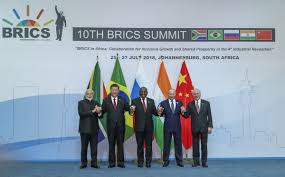The 10th BRICS summit in July 2018 in Johannesburg attached significance as it was held at an important conjuncture when the global free trade is feared to be in jeopardy. It was a departure from the set agenda of internal issues of member nations and was an assertion to shield the multilateral trading system. A report for Different Truths.
BRICS accounted for 23 percent of the world economy, 16 percent of world trade and contributed 50 percent to global economic growth. Given these high stakes in the global economy, trade war opens a new opportunity for BRICS to play a dynamic role to protect the global multilateral trading system, which is in jeopardy after the USA signaled trade unilateralism.
A Chinese media suggested that China should solidify BRICS and resist protectionism in three ways. First, China should gather support from BRICS members for its role against the US unilateralism. Second, China should increase its imports from BRICS countries. Third, China can keep BRICS members informed about the progress of Sino-USA trade negotiations.
In the initial stages, BRICS summits were bogged down by issues relating to internal cooperation among the member countries. The global issues had little space for consideration unless they were related to member countries. Until the 4th summit, BRICS made no breakthrough in its multilateral cooperation. The 5th summit in Durban in 2013, after South Africa joined in 2010, witnessed some signs of progress with the decision for setting up the BRICS Development Bank and CRA (Continental Reserve Arrangement), under the initiative of former Prime Minister Manmohan Singh. The subsequent summits observed BRICS as on important turf for mitigating the political tiffs, triggered by the rise in terrorism in Pakistan and China’s silence on it.
The 10th BRICS summit in July 2018 in Johannesburg attached significance as it was held at an important conjuncture, when the global free trade is feared to be in jeopardy. It was a departure from the set agenda of internal issues of member nations and was an assertion to shield the multilateral trading system. In the joint declaration at Johannesburg, the five member countries expressed concern over the disruption of the multilateral trading system, saying it was facing “unprecedented challenges” and urged countries to keep the world economy open so that the benefits of globalization can be shared by all countries.
Expressing concern over the imminent negative impact of Sino-US trade conflict on the world economy, a Chinese think tank, Global Times, envisioned that this would bring China closer to Russia, indicating a shift in the world power game. It said, “Russia views the trade friction as one of the steps taken by the US to contain China’s rise and avoid a challenge to its hegemony.”
Albeit, India is unlikely to follow China’s call for total globalization. It will mar India’s innovative manufacturing programme Make in India. Though India has been dragged into the controversy over export subsidies by the US, which is non-WTO compliant, India will continue with its import substitution programme.
India believes that Chinese pro-globalisation stand stems from its economic structure, which is an export-based economy. China is the biggest beneficiary of globalisation. This is the prime reason that China has been advocating globalization. Protectionism will restrict Chinese growth. According to Beijing custom official Huang Songpin, “The trend of anti-globalization is becoming increasingly evident, and China is the biggest victim of the trend.”Given protectionism intensifying in Trump era, fears loom over Chinese growth.
The Sino -US trade war is not a short term tiff. It is a long term conflict between protectionism and free trade. It will linger and no body knows when it reaches the end game. In the wake of the trade war, China needs India more than India needs it. This was evidenced by China diluting its fireballs against India, even though India refused to be party to Chinese BRI initiative (Belt and Road Initiative). China began extolling India’s economic power with its large domestic market and IT prowess. Amidst the trade turmoil, a new pattern of economic partnership has emerged among the BRICS member countries. This generated a new hope for better economic relations between India and China, despite adverse political relations and augmentation of Sino-Russia and Sino Africa economic relations.
Like the USA, India also succumbed to Chinese dumping of goods. This led a number of domestic industries facing sluggish growth and some are on the verge of closing. According to a Standing Committee report for Rajya Sabha, six industries were direly dented by Chinese cheap exports to India. They are pharmaceutical raw materials, solar industry, man-made fibre industry, toy industry, firecracker and bicycle industries.
But, India is unlikely to be harsh against China at this juncture, when the world is getting caught in the crossfire between globalisation and protectionism. One of the reasons is that China is emerging as a new destination for India’s exports and as a new foreign investor in the country.
China is planning to import more from India, along with other countries. It has decided to reduce the import tariff on 8,500 items from India and other Asian countries. To fill the gap of soybean, China contemplated zero duty import from India, against 3 percent at present.
Except for India, China is the major export destination for BRICS countries. It is the export market for Brazil and South Africa and second biggest for Russia. China accounted for 18 percent of Brazil’s global exports. The most important export item of Brazil is iron ore. China accounts for 47 percent of Brazil’s export of iron ore.
Similarly, China is the second biggest stakeholder for Russian oil purchase. Oil is the biggest export earning of Russia, sharing about 70 of its global exports. China accounts for 15 percent of Russia’s oil export. Therefore, China is the pivot to Russia’s export.
China is the biggest trade partner of South Africa. It is the biggest importer of South Africa iron ore – the second biggest item of South Africa exports.
For India, BRICS is significant for its infrastructure funds. India needs US$ 1 trillion investment for infrastructure development. To this end, setting up of BRICS National Development Bank (NDB) ensures a big support to India.
Given these intrinsic interdependence of BRICS member countries, the trade war has led to a new era for BRICS institutional framework for its dynamic role in world economy and for the BRICS member economies.
Subrata Majumder
©IPA Service
Photo from the Internet





 By
By

